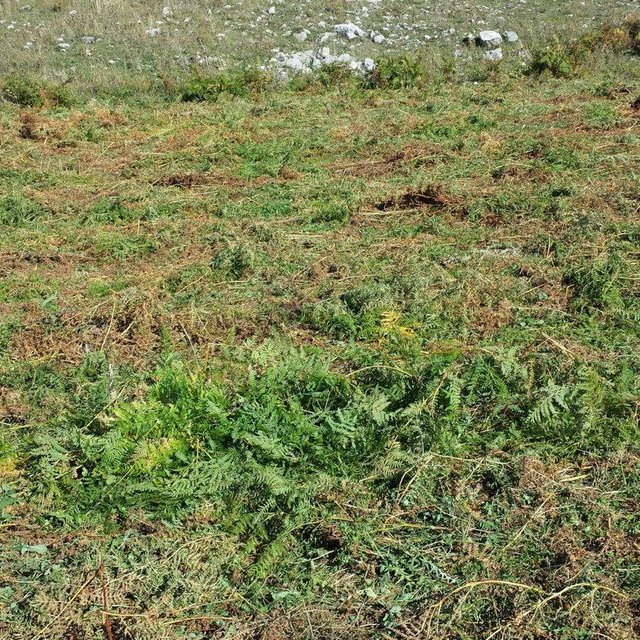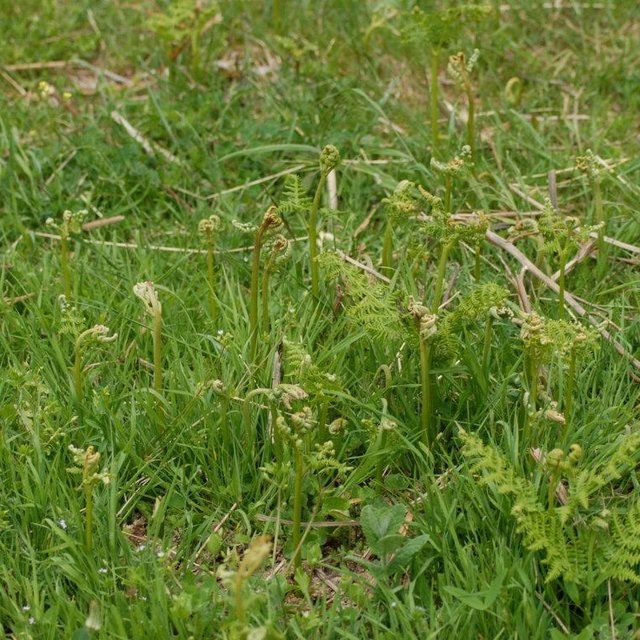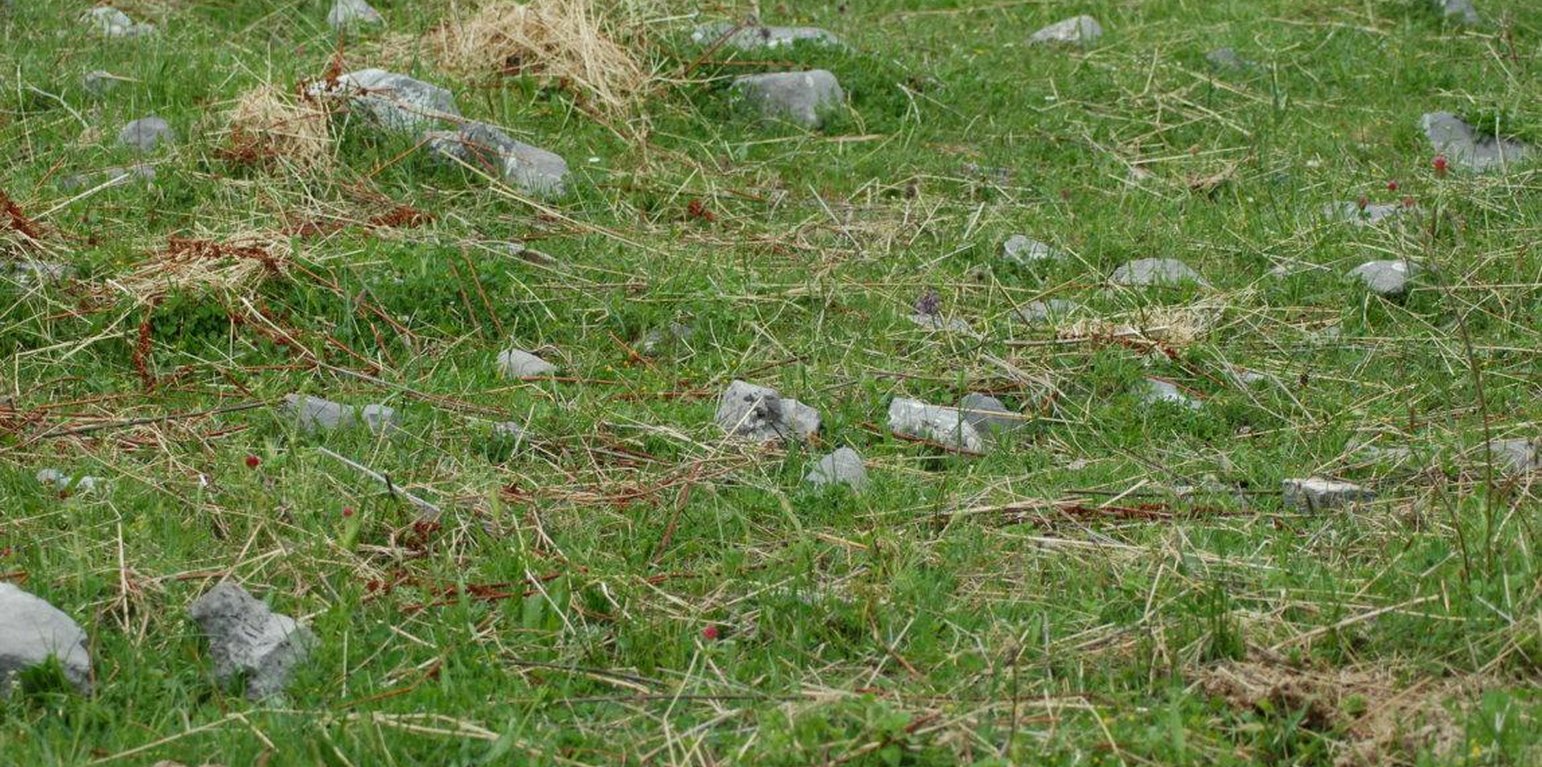Cutting of Ferns in degraded pastures to use as litter and fodder
(Italy)
Description
Cutting of wild ferns for fodder production and to mitigate pasture degradation.
Ferns are considered pioneer plants because Wherever there is fertile, acidic and well drained land Ferns (Pteridium sp.) preceed shrub species and the encroaching of forest species. Ferns that develop on pastures are fairly un-palatable to grazing livestock and completely disregarded by animals when the plant is fresh. The plant is thus usually mowed down to clear pastures and make way for more palatable species which would otherwise be suffocated by the presence of ferns. However, once cut down, dried and gathered, ferns can be used during the winter months (when the animals are in sheds or stables), both as a source of fibre and as bedding in deep litter housing systems (in place of the more common use of straw).
Purpose of the Technology: Improve pasture quality and gathering of fodder/ litter
Establishment / maintenance activities and inputs: End of summer/beginning of fall farmers use to cut ferns in the fields where they are diffused. Usually they use tractor whit a cutting equipment. As they get dry (it takes from 3 to 6 days according to air temperature and humidity) the ferns are collected and stored for winter use, either as fodder or litter housing.
Natural / human environment: The context of production is characterised by a medium level of mechanisation (only the most demanding operations are carried out using mechanical means), the production system is essentially mixed, a small part is destined for personal consumption whilst the bulk of production is destined for local markets. The property is predominantly privately owned but also includes some public land, especially in the case of pasture land. Most farms in the area are livestock farms whilst the agricultural component is destined exclusively for private consumption. The technique is mainly applied on higher latitude pasture land (because of the presence of acidic soils) which are not particularly stony.
Location
![]()
Location: castelsaraceno, Basilicata, Italy
No. of Technology sites analysed:
Geo-reference of selected sites
Spread of the Technology: evenly spread over an area (approx. 0.1-1 km2)
In a permanently protected area?:
Date of implementation: more than 50 years ago (traditional)
Type of introduction
-
through land users' innovation
-
as part of a traditional system (> 50 years)
-
during experiments/ research
-
through projects/ external interventions

(Giovanni Quaranta)

(Giovanni Quaranta)
Classification of the Technology
Main purpose
-
improve production
-
reduce, prevent, restore land degradation
-
conserve ecosystem
-
protect a watershed/ downstream areas – in combination with other Technologies
-
preserve/ improve biodiversity
-
reduce risk of disasters
-
adapt to climate change/ extremes and its impacts
-
mitigate climate change and its impacts
-
create beneficial economic impact
-
create beneficial social impact
Land use
-
Grazing land
- Semi-nomadic pastoralism
- Ranching
Animal type: goats, sheep, cows
Water supply
-
rainfed
-
mixed rainfed-irrigated
-
full irrigation
Purpose related to land degradation
-
prevent land degradation
-
reduce land degradation
-
restore/ rehabilitate severely degraded land
-
adapt to land degradation
-
not applicable
Degradation addressed
-
biological degradation - Bs: quality and species composition/ diversity decline
SLM group
-
pastoralism and grazing land management
-
fodder production and mitigation pasture degradation
SLM measures
-
vegetative measures - V2: Grasses and perennial herbaceous plants
-
management measures - M5: Control/ change of species composition
Technical drawing
Technical specifications
Establishment and maintenance: activities, inputs and costs
Calculation of inputs and costs
- Costs are calculated:
- Currency used for cost calculation: euro
- Exchange rate (to USD): 1 USD = 0.74 euro
- Average wage cost of hired labour per day: 81.08
Most important factors affecting the costs
The technique does not require specific investment given that the necessary equipment is usually already available on farm in the case of medium to large size livestock farms. The work is carried out in autumn when the machinery are not generally in use as haying operations are usually finished in the summer months.
If the farm does not own suitable machinery it can be rented at a cost of €40 per hour.
Establishment activities
n.a.
Maintenance activities
-
Cutting and gathering of fern (Timing/ frequency: Once a year)
-
Cutting and gathering of ferns (Timing/ frequency: Once a year)
Maintenance inputs and costs
| Specify input |
Unit |
Quantity |
Costs per Unit (euro) |
Total costs per input (euro) |
% of costs borne by land users |
|
Labour
|
| Cutting and gathering of fern |
ha |
1.0 |
162.16 |
162.16 |
100.0 |
|
Equipment
|
| Cutting and gathering of fern |
ha |
1.0 |
108.1 |
108.1 |
100.0 |
| Total costs for maintenance of the Technology |
270.26 |
|
| Total costs for maintenance of the Technology in USD |
365.22 |
|
Natural environment
Average annual rainfall
-
< 250 mm
-
251-500 mm
-
501-750 mm
-
751-1,000 mm
-
1,001-1,500 mm
-
1,501-2,000 mm
-
2,001-3,000 mm
-
3,001-4,000 mm
-
> 4,000 mm
Agro-climatic zone
-
humid
-
sub-humid
-
semi-arid
-
arid
Specifications on climate
Average annual rainfall in mm: 1519.0
68% in winter and 15% in summer
Thermal climate class: temperate
Slope
-
flat (0-2%)
-
gentle (3-5%)
-
moderate (6-10%)
-
rolling (11-15%)
-
hilly (16-30%)
-
steep (31-60%)
-
very steep (>60%)
Landforms
-
plateau/plains
-
ridges
-
mountain slopes
-
hill slopes
-
footslopes
-
valley floors
Altitude
-
0-100 m a.s.l.
-
101-500 m a.s.l.
-
501-1,000 m a.s.l.
-
1,001-1,500 m a.s.l.
-
1,501-2,000 m a.s.l.
-
2,001-2,500 m a.s.l.
-
2,501-3,000 m a.s.l.
-
3,001-4,000 m a.s.l.
-
> 4,000 m a.s.l.
Technology is applied in
-
convex situations
-
concave situations
-
not relevant
Soil depth
-
very shallow (0-20 cm)
-
shallow (21-50 cm)
-
moderately deep (51-80 cm)
-
deep (81-120 cm)
-
very deep (> 120 cm)
Soil texture (topsoil)
-
coarse/ light (sandy)
-
medium (loamy, silty)
-
fine/ heavy (clay)
Soil texture (> 20 cm below surface)
-
coarse/ light (sandy)
-
medium (loamy, silty)
-
fine/ heavy (clay)
Topsoil organic matter content
-
high (>3%)
-
medium (1-3%)
-
low (<1%)
Groundwater table
-
on surface
-
< 5 m
-
5-50 m
-
> 50 m
Availability of surface water
-
excess
-
good
-
medium
-
poor/ none
Water quality (untreated)
-
good drinking water
-
poor drinking water (treatment required)
-
for agricultural use only (irrigation)
-
unusable
Water quality refers to:
Is salinity a problem?
Occurrence of flooding
Characteristics of land users applying the Technology
Market orientation
-
subsistence (self-supply)
-
mixed (subsistence/ commercial)
-
commercial/ market
Off-farm income
-
less than 10% of all income
-
10-50% of all income
-
> 50% of all income
Relative level of wealth
-
very poor
-
poor
-
average
-
rich
-
very rich
Level of mechanization
-
manual work
-
animal traction
-
mechanized/ motorized
Sedentary or nomadic
-
Sedentary
-
Semi-nomadic
-
Nomadic
Individuals or groups
-
individual/ household
-
groups/ community
-
cooperative
-
employee (company, government)
Age
-
children
-
youth
-
middle-aged
-
elderly
Area used per household
-
< 0.5 ha
-
0.5-1 ha
-
1-2 ha
-
2-5 ha
-
5-15 ha
-
15-50 ha
-
50-100 ha
-
100-500 ha
-
500-1,000 ha
-
1,000-10,000 ha
-
> 10,000 ha
Scale
-
small-scale
-
medium-scale
-
large-scale
Land ownership
-
state
-
company
-
communal/ village
-
group
-
individual, not titled
-
individual, titled
Land use rights
-
open access (unorganized)
-
communal (organized)
-
leased
-
individual
Water use rights
-
open access (unorganized)
-
communal (organized)
-
leased
-
individual
Access to services and infrastructure
employment (e.g. off-farm)
drinking water and sanitation
Impacts
Socio-economic impacts
production area (new land under cultivation/ use)
Socio-cultural impacts
Improved livelihoods and human well-being
Off-site impacts
damage on neighbours' fields
Cost-benefit analysis
Benefits compared with establishment costs
Short-term returns
very negative
very positive
Long-term returns
very negative
very positive
Benefits compared with maintenance costs
Short-term returns
very negative
very positive
Long-term returns
very negative
very positive
Climate change
Gradual climate change
annual temperature increase
not well at all
very well
Climate-related extremes (disasters)
not well at all
very well
not well at all
very well
not well at all
very well
not well at all
very well
Other climate-related consequences
not well at all
very well
Adoption and adaptation
Percentage of land users in the area who have adopted the Technology
-
single cases/ experimental
-
1-10%
-
11-50%
-
> 50%
Of all those who have adopted the Technology, how many have done so without receiving material incentives?
-
0-10%
-
11-50%
-
51-90%
-
91-100%
Has the Technology been modified recently to adapt to changing conditions?
To which changing conditions?
-
climatic change/ extremes
-
changing markets
-
labour availability (e.g. due to migration)
Conclusions and lessons learnt
Strengths: land user's view
-
ferns are used in winter as fodder which absorbs the cost of cutting and gathering ferns from pastures and also helps improve pasture quality.
Strengths: compiler’s or other key resource person’s view
-
the cutting of ferns is a simple, low-cost operation
which brings great benefits to livestock farms.
How can they be sustained / enhanced? Greater exchange of information amongst target
farmers on the benefits of clearing pastures.
Weaknesses/ disadvantages/ risks: land user's viewhow to overcome
Weaknesses/ disadvantages/ risks: compiler’s or other key resource person’s viewhow to overcome
References
Reviewer
-
Fabian Ottiger
-
Alexandra Gavilano
Date of documentation: July 18, 2014
Last update: April 18, 2019
Resource persons
-
Velia De Paola - SLM specialist
-
Giovanni Quaranta - SLM specialist
Full description in the WOCAT database
Documentation was faciliated by
Institution
- University of Basilicata - Italy
Project
- Catastrophic shifts in drylands (EU-CASCADE)









